|
|
Sweetmeat

|
|
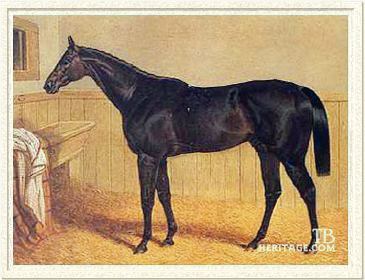 |
|
|
Sweetmeat was an unbeaten three year old who did well at a distance; he extended the influence of the Highflyer sire line through his good sons Parmesan and Macaroni, both of whom sired classic winners, and a number of good steeplechasers were near descendants of his. However, is through Macaroni's daughters, primarily when bred to Bend Or, and through the daughters of Cremorne, a son of Parmesan, that Sweetmeat's influence persists to the present.
|
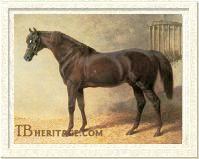
Gladiator
| |
Sweetmeat's sire was Gladiator, who retired from his very brief career on the turf soon after his second place finish to Bay Middleton in the 1836 Epsom Derby. Gladiator went on to become an important sire in France, but before his export he got Sweetmeat and one of the breed's most influential nineteenth century broodmares, Queen Mary, foaled in 1843 from a daughter of Derby winner Plenipotentiary. Queen Mary did nothing of note on the turf, but in the stud she produced, among others, Bonnie Scotland, winner of the Doncaster Stakes and Liverpool St. Leger and later a leading sire in the U.S., and the great Derby and Oaks winner Blink Bonny, later dam of English Triple Crown winner and four-time leading sire Blair Athol.
|
In France, where he spent ten years before his death, Gladiator got the influential Fitz-Gladiator, sire of classic winners and of sire sons that bred on, French Derby winner Ventre St. Gris, who got some top steeplechasers, French Derby winner Celebrity, and three winners of the French Oaks. He was also damsire of the great French horse Gladiateur, who crossed the channel to win the English Triple Crown. Up until the end of the nineteenth century, it was rare to find a French-bred horse without at least one strain of Gladiator in its pedigree.
Sweetmeat's dam was Lollypop, a black filly bred in 1836 by Major Nicholas Yarburgh, a major in the third regiment provisional militia and a High Sheriff of Yorkshire in 1836, whose estate, Heslington Hall, was located on the outskirts of York. The major had also bred her dam, Belinda (1825), by Blacklock, and Belinda's dam, the influential Wagtail (1818) by Prime Minister. Wagtail (Family 21) was the dam of St. Leger and Doncaster Cup winner Charles XII (1836) and ancestress of such horses as Janus, John Bull and Bachelor's Double, and, much later, In Reality. Her daughter, Belinda, was tail-female ancestress of such twentieth century horses as Exceller, Broad Brush, and Le Ksar. In addition to Sweetmeat, Lollypop produced a filly by Don John (1848) who was tail-female ancestress of Hastings, Plaudit, and Victorian, among others. She was dam of twelve other foals before she was shot at age 21, having, after Yarburgh's death, passed into the hands of Colonel (later General) George Anson, and then, in her final years, to the Rawcliffe Stud in Yorkshire.
Lollypop was by either Starch or Voltaire, as noted in the General Stud Book, with Voltaire listed second, the position generally considered to be the more likely sire. Her breeder, said the turf writer, The Druid, "...always maintained she was by Voltaire; but, knowing the Major's wonderful partiality for this blood, so well represented in his favourite Laurel; might not the wish in Lollipop's [sic] case, have been father to the thought?" Laurel, a son of Wagtail, and by Blacklock, won the Doncaster Cup, among other races, for the Major, who also retained Charles XII for racing. Voltaire (1826), a Doncaster Cup winner, among other races, was by Blacklock and was sire of Charles XII, and of dual-classic winner Voltigeur, sire of dual-Doncaster Cup winner Vedette, who in turn got multiple leading sire Galopin.
The Druid could find no trace of Blacklock in Sweetmeat's appearance, which may have precipitated his comments regarding his pedigree; Blacklock was a heavy-boned "great half-moon" headed, "half-thick of a horse" with questionable forelegs and a huge stride. Sweetmeat had a lovely head and neck, and was much lighter in bone, but these were features of his sire, Gladiator. The other listed sire of Sweetmeat, Starch, bred in Ireland in 1819, was a son of Waxy Pope; in Ireland Starch got the mare Ellen, who is seen some generations back in the tail-female line of Hermit, and he must have been sent to England after her dam, Cuirass was bred in 1830. His other offspring were not winners of major races, nor did they produce anything of note.
Sweetmeat on the Turf
Although A.W. Hill of Berkshire is listed as the breeder of Sweetmeat, he purchased Sweetmeat, who was rather small, as a foal for 20 guineas from Major Yarburgh. He debuted in Hill's colors at age 2 in July at Liverpool, winning the first time out in the Stanley Stakes, carrying 6 st. 12 lbs., beating the future Goodwood Stakes and Goodwood Cup winner, Miss Elis, who ran third. At Wolverhampton he won again, a £220 sweep, beating six other two year olds. He won his third race against other juveniles at Wrexham, and then ran second in the Nottingham Stakes for two year old for colts and fillies, his last outing of the season.
At age three he went unbeaten in sixteen races, including a number of walk-overs, in a busy schedule that encompassed most of the country. Not eligible for the classics, he still ran against a respectable group of horses, proving to be a good distance runner. He won the two-mile Ascot Gold Vase, beating The Libel (also owned by Hill), and three others, and the 2- 1/4 mile Doncaster Gold Cup, beating the great mare Alice Hawthorne who had won it in the two previous years, Miss Elis (Goodwood Stakes winner), and the colt Pantasa. His other wins including the Warwick Trial Stakes; the Somersetshire Stakes at Bath; the Cleveland Handicap at Shrewsbury; a handicap at Shrewsbury, beating the race mare Inheritress, age 5, and later a match against her for 150 sovereigns; the Derby Handicap at Liverpool, beating the Liverpool Cup winner Lothario; the Grosvenor Stakes; a race at Newton. He divided forfeits with Princess Royal in the Wynnstay Stakes, and his walk-overs included the Salopian Stakes at Shrewsbury, the Swinley Stakes, a race at York for £60, a walk-over at Oswestry for £75, the Bryn Stakes and the Cup at Wrexham, and a race at Knutsford and the Knutsford Cup.
Sweetmeat only ran once at age four, the Cup at Chester; he went unplaced in that race. At age five he started in the Cheshire Stakes at Chester, and once again ran unplaced, apparently a foreleg "gave way."
He was purchased for 300 guineas by industrialist William Cookson for his stud at Neasham Hall, near Darlington in County Durham. Sweetmeat went blind in one eye while at Neasham, and ten days later lost the sight of his other eye. In 1861, age 19 and blind, he was sold for 800 guineas to Prussia, and died soon after arriving. His best son, MACARONI, was two years away from his Derby win at the time of Sweetmeat's sale, and the value of his son, PARMESAN, as a sire had yet to be revealed; a few years later, his expatriation and subsequent death was bemoaned by more than a few turf enthusiasts.
Sweetmeat in the Stud
According to The Druid, Sweetmeat was a "fitful getter of stock, as regarded size, although he seldom failed in giving them rare speed, and a dislike to distance. His colts, as a rule, were too big; Parmesan, however was a notable exception, and through him, the Sweetmeat blood has attained among breeders a degree of popularity equal to that of Defence."
He got two classic-winning daughters, and one really exceptional son, Macaroni, who won the Derby and 2,000 Guineas, the Doncaster Cup, and other races, who in turn sired several classic winners and also became an excellent broodmare sire. Another son, Parmesan, was a good winner, and got two Derby winners and a winner of the French Oaks. Two other Sweetmeat sons, Plum Pudding and Saccharometer, sired top steeplechasers, and several other good jumpers show up in his descendants, just a few generations removed from him.
|
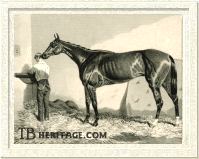
Mincemeat
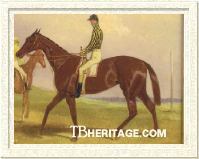
Mincepie
|
MINCEMEAT was Sweetmeat's first classic winner. Out of Hybla, by The Provost, she was born in 1851, bred at Neasham by William Cookson. She was a promising juvenile, placing second to Andover (who won the Derby a year later) in the Molecomb Stakes for colts and fillies, and dead-heating for second in the Rutland Stakes for colts and fillies, behind the filly Delia. She then won the Bedford Stakes at Newmarket, beating the good filly Spinaway, who later won the Chesterfield Stakes. At age three she began the season by winning the Epsom Oaks, beating Meteora (second place in the 1,000 Guineas) by two lengths, and some other good fillies; following this win she was sold to Baron Mayer de Rothschild. She ran twice more, in the Chesterfield Cup Handicap, and the Warwick Cup, unplaced in both events, and was retired to the Rothschild stud.
She was continuously bred to Rothschild's favorite stallion, King Tom, and from him produced Tomato (1861), who won the 1,000 Guineas and the Ascot Stakes, and later bred on. An unnamed Mincemeat daughter by King Tom, bred to Perplexe, produced the fair sire Palais Royal (1880) and his sister, Perplexite (1878), the latter a good juvenile in France, winning the Grand Criterium, and at age three going on to win the Prix Royal Oak (French St. Leger). Perplexite produced the sires Buisson Ardent (1895) and Tournesol (1890), and two Prix du Jockey Club (French Derby) winners, Chene Royal (1889) and Palmiste (1894, brother to Buisson Ardent, both by Le Sancy).
|
MINCEPIE, Sweetmeat's second classic winner, was a filly of 1853 from the Birdcatcher mare Foinnualla, was bred in Ireland, as was her brother, PLUM PUDDING (see below). She was purchased by the gambler Henry Hill, and made her first appearance on the turf at Stockbridge, where she won the Mottisfont Stakes for colts and fillies. Her second race was at Newmarket, a Post Match of 500 sovereigns against the Harkaway colt, Cheerful Horn, whom she beat by ten lengths. At age three, she began with a second place, behind Manganese, in the 1,000 Guineas, and followed that by winning the Oaks at Epsom, beating a modest field, that did include Victoria, later winner of the Coronation Stakes and the Yorkshire Oaks. She did not place in the Stockbridge Derby, but went on to win the Nassau Stakes at Goodwood, and followed that by running second in the fillies-only Park Hills Stakes at Doncaster. At Newmarket, she ran second to Fisherman in a free handicap for three-year-old colts and fillies. At age four she ran three times, including the Chester Cup and the Cup at Epsom, but ran unplaced, apparently unable to compete against such colts as Leamington and Drumour (Chester Cup winner and second place horses), and Sir Colin and Chevalier d'Industrie (first and second at Epsom). She was one of Sweetmeat's best racing foals, although it's difficult to judge how good, since her owner, Hill, was known to illegally influence races through various means. She was purchased by Lord Portsmouth for his stud at the end of 1857, and was bred to Voltigeur in 1858, producing a colt in 1859 that died ten days after foaling. In the fall of that year Mincepie died from the result of a kick.
Other Sweetmeat daughters did well on the track, albeit not at such elevated levels. COMFIT ran second to the Rothschild filly Mentmore Lass in the 1853 1,000 Guineas; she was, according to The Druid, "perhaps the sweetest of all his daughters." NETTLE, from the 1851 crop and out of the Muley Moloch mare Wasp, won the Gimcrack Stakes; she was third dam, through her good daughter Thistle, of the stallions Common (1888, by Isonomy) and Goldfinch (1889, by Ormonde), and of the good Petrarch filly Throstle (1891). SWEET HAWTHORN produced Yorkshire Oaks winner Rebecca (1868, by Lord Clifden), and was second dam through another daughter, Young Alice, of Irish Derby winner Ben Battle (1871, by Rataplan), as well as tail-female ancestress of a number of good horses, such as Oaks and 1,000 Guineas winner Miss Jummy, Criterion and Gimcrack Stakes winner Polar Star (1904), Preakness Stakes winner Colonel Holloway (1909), and North Star III (1914). Many other small, neat Sweetmeat daughters bred on, populating races into the next several decades.
Sweetmeat's Sons
Sweetmeat's sons were generally good runners, but MACARONI was the only truly outstanding one. A number of his sons got good racehorses and jumpers, but only PARMESAN proved to be a modest sire of sires, and after Sweetmeat's grandsons, his sire line died out. However, through the daughters of Macaroni, and the Parmesan son Cremorne, Sweetmeat's name is still seen in pedigrees.
PARMESAN (1857) was bred by A. Johnstone from the Verulam mare Gruyere (1851); after he was weaned, his dam, in foal to Pyrrhus the First, was sold to Baron Kotze and sent to Prussia. Parmesan was a small horse, described as a "mere pony." He was sold to Henry Savilee, who had recently inherited the great Rufford Abbey estate in Nottinghamshire from his father. Savile placed Parmesan in training with William Gilbert. For Savile Parmesan won the Ascot Gold Vase and the Great Metropolitan Handicap in 1861, and ran third to Thormanby in the Ascot Gold Cup. Savile later raced Parmesan's best racing son, Cremorne.
Parmesan was a good sire in his era, getting two Derby winners -- Favonius and Cremorne -- and a winner of the French Oaks, Brie. Unfortunately his best sire sons, Cremorne and Stracchino, while good filly getters and broodmare sires, did not get sons who could continue the sire line. Parmesan was the grandsire of two top 'chasers, Le Torpilleur in France (Grand Steeple Chase de Paris) and Voluptuary in England (Grand National), and the leading steeplechase sire in Great Britain in the second decade of the twentieth century, Wavelet's Pride, was the grandson of Parmesan's daughter Wanda.
|
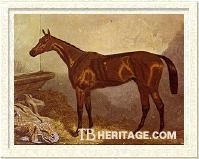
Dual classic winner Macaroni became a great broodmare sire
| | The dark bay Sweetmeat son MACARONI was born in 1860 at the Duke of Westminster's Eaton Hall. He was from the Pantaloon daughter Jocose, a filly bred by Duke from Banter, the latter the dam of Touchstone. Like his sire, he was unbeaten at age three, winner of the Two Thousand Guineas, the Derby, and the Doncaster Cup, among other races, clearly the best of his generation. In the stud he got some excellent daughters, including three Oaks winners and a Doncaster Cup winner, and a son, MacGregor, that won the Two Thousand Guineas. He was an excellent broodmare sire, known for his "nick" with Bend Or noted by many turf writers.
|
Another son of Sweetmeat's was MUSCOVADO (1851), from Surprise. Sent to Australia, he sired the good race horse Lantern (1861) who won both the VRC Derby Stakes and the Melbourne Cup; The Sign (also 1861), winner of the VRC Royal Park Stakes and the Adelaide Racing Club South Australian St. Leger Stakes, and the good filly Lubra (1860), who won the South Australian Derby and later produced the SAJC Adelaide Cup winner Ace of Trumps (1868).
|
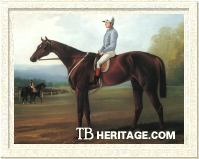
Sweetsauce
| | Sweetmeat's son SACCHAROMETER (1860, from Defamation), was a good two year old, running second in the 2,000 Guineas to Macaroni, and winning Newmarket's July Stakes and the Chesterfield Stakes, among others. A son of his, Vanderdecken, was a good winner, had some influence at stud, and another son, Shifnal (1869), won the Grand National at Aintree.
SWEETSAUCE (1857), by Sweetmeat from the Harkaway mare Irish Queen was a good runner who placed in all his races at age 2, and went on at age 3 to win the Steward's Cup at Goodwood, and then the Goodwood Cup, and several other races. Another son, SPICEBOX (1857), dead-heated for the win of the 1861 York Gold Cup. Son COMQUOT (1854) won the Chesterfield Cup at Goodwood at age 3.
|
Another Sweetmeat son, PLUM PUDDING (1857), was sent to stud in Ireland, where he sired Grand National, winner of the 1876 Irish Grand National, and Billy Pitt, winner of the Irish Derby. Plum Pudding's daughter, Silk (1869) was the dam of Master Kildare, unbeaten two-year-old in Ireland, and a good weight-carrier who was winner of a number of races in England to age five, including Epsom's City and Suburban Handicap and the Liverpool Autumn Cup.
--Patricia Erigero
|
|
|
|

